
Discovering Balance Through Yogic Movement
Yoga is about balance. In the realm of movement and physicality this means that genuine whole life yoga physical practices will work across the spectrum of holistic health and fitness for life.
YOGIC BALANCE MEANS:
- Strength and suppleness
- Fluidity and steadiness
- Quickness and easefulness
- Yogic movement practices promote the capacity to: stimulate and soothe, to activate and to calm, to heat and to cool, to accelerate or decelerate the metabolism as desired, to gather energy in and to transmute excess energy skilfully and nourishingly.
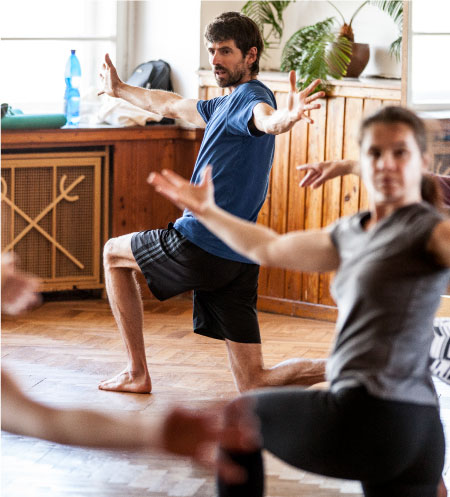
Nurturing Balance and Awareness
Classically yoga is described as evenness, balance, integration and harmony (samatava) and as skilfulness and efficiency in our actions (karmasu kauśalam).
YOGIC MOVEMENT THUS SEEKS TO DEEPEN AND IMPROVE:
- Efficiency of energy consumption
- Coordination and capacity to organise the body and energy systems easefully in dynamic response to changing situations and surroundings
- Awareness of the body in space, and the relative balance and efficiency of its movement patterns
- The capacity for deep rest, stillness and efficient recharching of energy
- The capacity for sustained challenging work and concentrated effort
- The capacity to move fluidly between rest and activation, to relax and sleep easily and to move into activity gracefully.
- Virtuosity in the art of living, ageing and dying.
These days many people’s first encounter with yoga is through some type of class relating to yoga āsana. Sometimes people have the perception that yoga is ‘stretching’. Others think of it as a holistic fitness modality. When we explore more deeply the principles of haṭha yoga – the practical, Tantric school that yoga posture practices are in some way derived from, we find that yoga posture is not really about stretching. Also, though yoga is not specifically a physical fitness discipline, its principles and aims relate very practically to physical fitness and indeed can be a great guide to building robust, adaptable all round fitness for life.

Nourishing the Body-Mind
with Motion
Yoga is about balance and in order to promote it a diet that supports and promotes balance can be really helpful. Diet in this sense does not just mean what we eat in terms of alimentation, but more broadly in terms of how we consume and express through our sense and action powers. When it comes to movement, a nourishing diet needs to stimulate the various powers, capacities and intelligences that have evolutionarily developed through our bodies. Our bodies thrive on regular and fairly varied motion.
Enhancing Life Through
Yogic Motion
Despite what some people have suggested, yogāsana-s were developed a long time ago. And they were developed by people who didn’t spend much time in chairs, who sat on the ground a lot, who always squatted for elimination and who would spend significant time in deep squats.
As such, the lexicon of postures in what might be referred to as classical modern yogāsana – as found in the methods developed from the schools linked to Krishnmacharya such as Iyengar Yoga, ashtanga-vinyasa yoga and viniyoga – assumes facility with the lotus posture and the deep squat, and a certain access to ranges of motion that are not so common for many people who grew up in chair-based societies for whom schooling involved systematic physical disabling as it does now all around the world. Whatever qualifications we graduate our school years with, or not, we most all leave school highly adapted to sitting in insalubrious postures that close and block many of the body’s key energy gateways. Many also leave school no longer able to get up and down from the floor as well as they could when they first went to school as a young child…
This is important to mention because it is people like us who go to yoga classes and encounter these classic yoga postures. One of the most common misperceptions around yogāsana is that the postures are ‘stretches’. Of course, many of them can be performed as stretching exercises, but that is not what they are really intended for. Yogāsana is not supposed to destabilise the joints and promote excess laxity in the body – consequences that are the natural result of a movement diet that focuses on stretching in excess. Rather, yogāsana is all about promoting easeful, balanced flow of energy and information around the bodily chariot. It is about cultivating easeful space and robust steadiness in the body, so that it can sit clear and steady and function clean and strong like a diamond to help face the challenges of life from a more resilient centre and ultimately to support the rigour of intense meditative practices so as to realise our essential nature. This is not the strength of the strong man or the resilience of the ultra-adventure-racer though, but something on a whole other subtler order. Something that is not really on the agenda for most human beings.
Yoga meets us where we are though, and is just as much for the person living actively in the world as for the ascetic on the brink of final emancipation.
When we have a bodily vehicle, we need to look after it. There are many daily habits and practices that yoga and its sister science Āyurveda advocates. These support mental, emotional, sensory, physiological and physical hygeine. Yogāsana practices of many varieties can be a tremendously beneficial part of daily habits. However, I would suggest that for many of us in the world today, yogāsana alone is not enough.
As well as being chair-eschewing, squatting to pee or defecate, walking most everywhere people, our yogāsana inventing ancestors also drew water from the well and the river, regularly carried fairly heavy stuff – fuel, food, water, children – significant distances, hunted and foraged and tended the land and their shelters. In short, they led active lives. Lives that involved plenty of motion that kept the body clean, flushing itself out and keeping its various energy systems well connected, exercised and lubricated.
When we customarily sleep in beds, sit in chairs and spend significant periods sitting, we do well to consciously reclaim much of our carelessly outsourced movement capacities and tend the chariot with regular loving care in the form of challenging, stimulating and nourishing engagement. In other words, plenty of regular movement, of various types and description, can be highly beneficial! As an old Chinese proverb reminds us, the hinges of the door that is constantly being opened and closed never rust.
Keeping the hinges of the body ‘lubricated’ and ensuring that energy flows regularly through the joints is tremendously supportive for the vitality and resilience of the bodily vehicle.
I have great esteem for yogāsana. In 2023 I had knee surgery following an accident that had occurred nineteen months prior. During that period I was not able to fully extend or flex the knee. However, I kept moving in diverse ways as best I could, rehabilitating as well as I could. After the surgery, which removed a flap of torn meniscus that had been stuck in the intercondylar notch of the fibia, the surgeon was amazed by how healthy the rest of the knee looked, despite the meniscal damage. Then a couple of weeks after when I started seeing physios they said they would have thought I was three months post surgery. It was encouraging to have these external and in the case of the surgeon who performed the arthroscopy, internal assurances that the yogāsana and the joint lubricating, spine moving daily practices I have had as parts of a lifelong practice of daily movement, often in several doses, really does work.
When I work with yogāsana and broader spectrum yogic movement I am seeking to cultivate a robust and resilience dynamic equilibrium. When I teach, my aim is to empower participants with tools to facilitate ongoing deepening understanding of how we can work with the innate gifts and capacities of the bodily vehicle, so it can support what we want to do in life, and facilitate joy, exuberance and steadiness.
Yoga is not merely about relaxing, or activating, about stretching or strengthening. Rather, yoga is about balance. Working with haṭha yoga principles of expansion and contraction, of heating and cooling, of stimulating and soothing, we can develop an adaptable toolkit that we can then employ to administer the appropriate dose of whatever we need to move more into the state that is optimal for the situation at hand. For example, if we need to ‘lively up ourselves’, we can take recourse to stimulating techniques that rouse and vivify. If we need to calm and quieten down, we can deploy techniques to encourage groundedness and relaxed focus. If we need to stimulate greater strength, we can do so in hundreds of ways. Similarly if we need to open or loosen up the body. As we deepen our understanding and appreciation of the principles of haṭha yoga, we can apply them in all types of movement and physical activity.
On immersive programs, we practice and experience how we can practice to gather and increase our energy, deepening our appreciation of how movement can be a work-in just as readily as a workout.
We also include spontaneity and unpredictable movement, games that engage our reflexes and quickness, that invite ‘yogic engagement’ by working with multiple senses and intelligences in movement situations.
This allows us to apply the principles that we explore more subtly in slower or more static work and in the laboratory of yogāsana whether it is relatively flowing and dynamic or steady and earthing.
This approach to yogāsana and yogic movement is about facilitating lifelong physical capacity, beauty, exuberance, expression and functionality. It supports robust physical health, elevated levels of lifelong fitness and can help make athletic pursuits more efficient and sustainable.
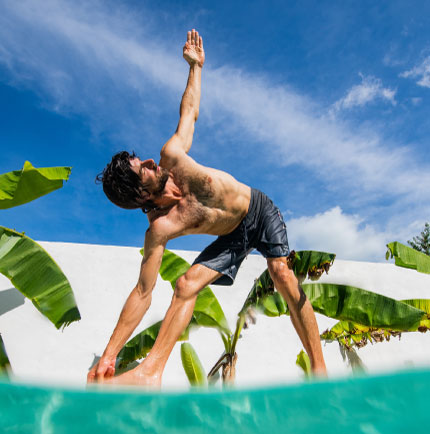
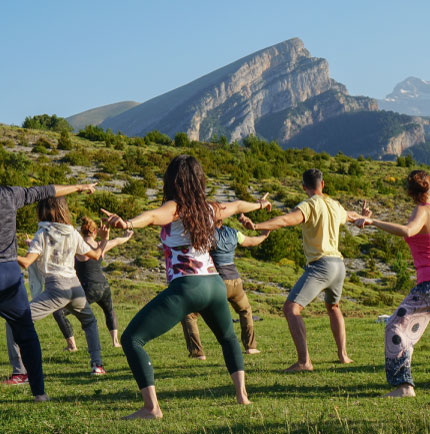
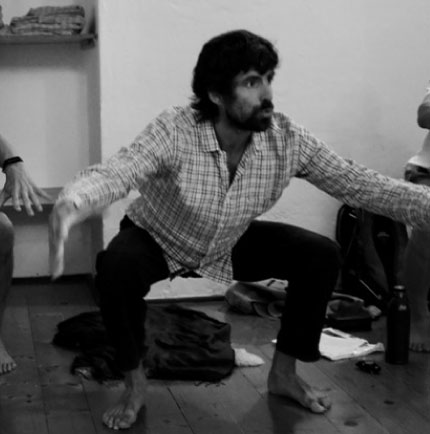
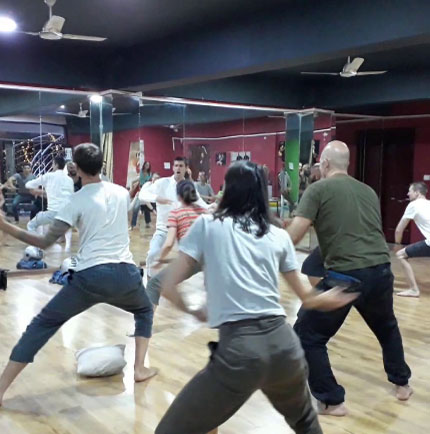
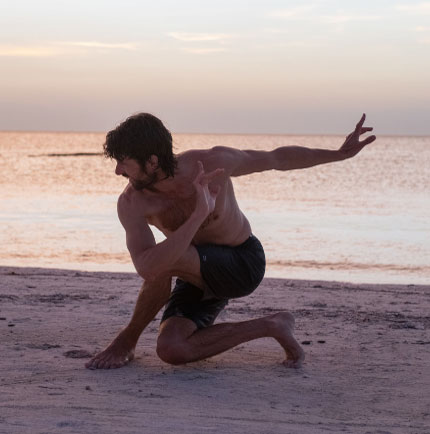
Frequently Asked Questions About Yogic Movement
This sounds a bit advanced, what if I am new to yoga or not used to moving so much?
Being principle-based, this approach is open to everyone. The work is always adaptable and scalable. For example, I have given classes in which there have been ninety-plus year olds and thirtysomething ultra-marathoners alongside each other in the same session. This is one of the key features of this approach: learning the underlying principles of movement, health and fitness, so we can work with them to nourish and stimulate our own, unique bodily vehicle through the different seasons and circumstances of life.
This sounds a bit lame, I’m a parkour pro/seasoned martial artist/strength/endurance athlete/crossfitter/professional dancer, is it really worth me coming to this ‘adaptable to anyone’ physical yoga practice?
Yes! Again, this is principle-based. My experience with crossfitters for example, is that they are blown away by how the modalities I share are working towards many of the same underlying aims as their regular practice, but through a different lens. A lens that can shed really helpful perspective on their regular practice and help refine and deepen it.
Strength and endurance athletes often report surprising and notable enhancements in performace: stroke efficiency improves, breathing gets easier, recovery is accelerated.
Martial artists, parkour athletes and movement generalists are often surprised by the depth of this yogic movement approach, how it complements their practices and provides resources to keep going deeper.
What style of yoga do you teach?
James, in 2015: “My practice and teaching are rooted in ‘classical’ yoga teachings of Patañjali’s Yoga Sūtra-s, the Bhagavad Gītā, and the Purāṇa-s/Indian Mythology. This is all also through the lens of what is sometimes referred to as the Yoga of Kashmir Shaivism, in the lineage of Abhinavagupta, as taught by Swami Lakshmanjoo last century. My first meditation teacher, Larry, was a long-term student of Maharishi Mahesh Yogi before he became Swami Lakshmanjoo’s close disciple. It was through Larry that I was introduced to the wonderfully inclusive and universal teachings of Kashmir Shaivism, Abhinavagupta’s extraordinary breadth of vision, experience and inclusivity and this wonderful lineage which works with all the Vedic and Tantric literature, and which is just as soaked in heartful bhakti or devotion as it is steeped in rigourous jñāna and inquiry.
What first drew me irresistibly to the teachings of yoga were their inclusivity and practicality. When Larry presented core teachings from the tradition, I was blown away by how utterly relevant and practical these ancient stories and teachings were, and how applicable and useful the principles enshrined therein were.
When I began practising daily āsana, and a couple of years later, daily meditation, I noticed things changing in my life, in ‘good’ ways, in the sense of in the ways I aspired to. The yoga practice was helping me bring a greater balance into my life, discover more of myself and provide me with the stability and confidence to meet more of my shadows and share in the world more wholly.
When I am in the role of the teacher, I am not affiliated to any modern yoga brand. I have explored some of them quite extensively, but for me the overarching principles are much more important than the details of different brands. Yes, certainly, aṣṭāṅga vinyasa revealed much to me about breath, prāṇa, energy, sustainability, balance, ambition, greed and insecurity; together with Iyengar yoga (the latter particularly with Justin Herold when I lived in Bangkok) it also helped me develop a basic understanding of the lexicon of modern yogāsana; working with Paddy McGrath transformed my āsana practice and helped more deeply empower me in the direction of a ‘brandless’ āsana practice, and I gained much valuable insight and understandings by studying with teachers from many different schools. However, for more than ten years, my āsana practice has been resolutely my own, very personal and geared to fostering balance, or yoga, in the broader context of my life.
This means that the work I do with physical ‘yogāsana’ practices is different every day. It also changes with the season and with the location. For example, when in Mysore in the early months of the year, I often do my morning āsana exploration on my rooftop, in front of the rising sun. The climate has changed dramatically in Mysore in recent years, and these days it can be very hot in January and February in the day time. An important aspect of my ‘yoga practice’ – the cultivation and deepening of balance in my life – is time outdoors. So when in Mysore I make a point of being outside in the earlier morning and later afternoons. If I’m in Northern England in the winter, where the days are short, I might rise early and do some āsana work in the dark, but I am more likely to go outside into the sunshine, or light rain and wind, and do the practice outside later in the morning, having had breakfast earlier. I know that there are those who are stuck on the idea that you have to ‘practice’ indoors, with a ventilation window above head height, or that you have to practice at a certain time… I’m stuck on the idea that the practice should help me feel more balance, more energy and better able to deal skilfully with the various challenges of the day. I try to make the whole day practice! And in order to do this, I need to make the time I work with āsana or other yoga techniques nourishing, so I practice what nourishes me, and I get outside as much as I can.
For about a dozen years, yoga āsana was the main physical activity I did in my life, and sometimes the only slightly demanding type of movement I would get in a day. And I paid a price…
Over the last few years, I have consciously been working with yoga principles of movement in a much broader spectrum of movement activities and have been finding this tremendously useful and nourishing.
In particular, my physical health and wellbeing, and my yoga āsana, in terms of being steadier and easier in my physical body, have been tremendously helped by ideas and the broader range of movement and principles of movement evolution and development that I have been inspired to explore by the work of Ido Portal, and other Functional/Natural Movement teachers/modalities.
In the realm of contemporary haṭha yoga, I find Simon Borg Olivier’s work fantastic, and his work is a significant influence in my āsana/movement practice and teaching, as are other teachers who have introduced me to techniques from Chinese yoga aka Chi Kung/Kung Fu/Tai Chi/martial arts. In my opinion, one of Simon Borg Olivier’s great gifts to contemporary yoga is his emphasis on doing yogāsana-s actively, against gravity, so we can learn how to really work in multiple directions; and this is something that I have been working with a lot in recent years.
If I am in the role of āsana teacher then, the way that I work will be in response to what is appropriate for the group or the individual. This will be different, for example, if I am working with a group or an individual who have a certain experience in a particular practice modality, who is recovering from trauma, who has certain limitations – and we all have certain limitations – or who is keen and ready to explore broader spectrum movement. The instruction, and what is done in the class can thus be very different in different situations.
The key element in any class I share is ‘yoga’ – the cultivation of harmony, balance and sustainable wellbeing.
In the integrated programs I like to share, each element is intended to help deepen an understanding of practical yoga principles and empower the students so they may readily implement these principles in their lives.
In yogāsana and yoga movement classes then, I seek to deepen an appreciation of what it means to foster balance and sustainability through different ranges and types of movement and how yogāsana techniques can help us balance and optimise our whole system (body, sense and motor powers, mind, emotions and intellect) energy.”
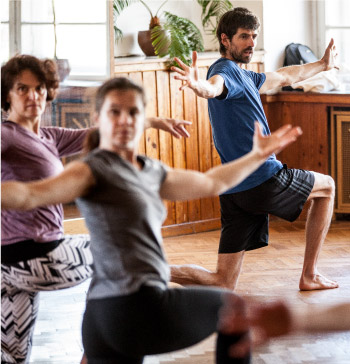
Programs
SIGN UP >
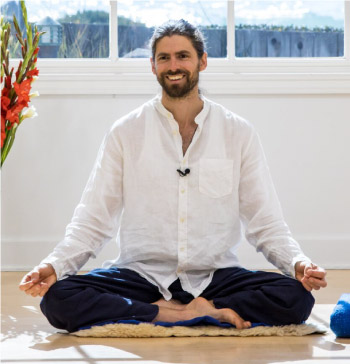
Work With James
LEARN MORE >

Store
COMING SOON
Whole Life Yoga Newsletter
The place to find out first about all James’ programs and offerings, receive articles, recommendations, and access special rates for programs.
